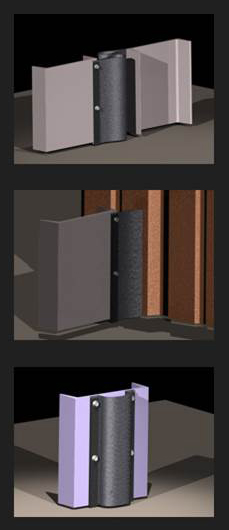Weather Seal Systems

Spec Sheets
Maintenance Tips
Testimonial
-
Precision Door Drive is a great company to work with that will bring the knowledge and up to date technology to the table in order to meet any requirements needed for their customers. They are a company that is fast, accurate and stands by their products.
Johnny Cortez, Drafting ManagerUnited Structures of America, Inc., HOUSTON,TX
-
We manufacture a complete line of customizable weather seal systems.
-
Weather Seals operate to not only keep the weather out - both rain and snow - but also prevent sand and birds from entering. Our seals are designed to save heat in the winter and keep the building cooler in the summer. Our well-designed seals can do all of that.
Which Weather Seal Material is Best?
The different types of material that can be used for seals are:
-
EPDM (C.I.) cloth inserted - BEST
Description: EPDM (ethylene propylene diene monomer) rubber with a cloth insert added incrementally throughout the thickness of the material. This process gives the material added durability and a higher degree of strength. It has excellent resistance to weathering, ozone, good to very good aging resistance, high and low temperature flexibility, oil resistance and UV stable.
-
Neoprene (C.I.) cloth inserted - VERY GOOD
Description: The cloth inserted Neoprene is an all-purpose elastomer and an extremely versatile synthetic rubber. It has excellent resistance to weathering, ozone, keeps its flexibility in high and low temperatures, oil resistant and UV stable but not as good as EPDM material. It will not squeeze or extrude out between the door and the retainer. It holds its shape and will not crack.
-
Neoprene non-reinforced - GOOD, but not recommended
Description: Non-reinforced neoprene is resistant to weathering, ozone, UV stable but not as good as EPDM material. Without the cloth insert, it lacks the strength to maintain its rigidity as a flap or bulb seal and, in time, it will crack in half. It will squeeze and extrude out between the door and the retainer.
-
Rubber (C.I.) cloth inserted - Not Recommended
Description: The cloth inserted rubber works well in environments where hot or cold water and gases are being used as a seal. It does not wear well, and it is not UV stable. The UV and ozone will dry out the material. It will become hard and crack and fall apart.
-
Brush Seals - Not the best application
Description: Brush seals come in 8 or 10 foot long sections made with a Nylon or Polypropylene 6 filament material with a galvanized steel or aluminum mounting holder. They have excellent abrasion resistance, flex life and springiness. The best application is closing gaps in machinery and conveyor systems, guiding and positioning in manufacturing processes, sealing machinery from chips and debris, cleaning and delicate wiping. Due to the rigid mounting holding channel, you cannot bend it up or down to conform to the uneven surface of the floor. If you try to force the brush seal filaments up or down, they will open up causing large gaps. The taller the brush seals are the more likely the filaments will curl up due to the UV and ozone causing the filament to deform, leaving gaps.
Specifications
Seals:
Thicknesses range from:
1/16" - 1 ply
1/8" - 2 ply
3/16" - 3 ply
NEOPRENE or EPDM material cut to any dimension for your application. NEOPRENE has cloth insert (CI).
Retainers:
Black HDPE (High Density Polyethylene) rather than a standard metal style, removing the need for painting.
1" wide
1/4" thick
4 or 8 ft. lengths
Pre-punched, one foot on center with 1/4" round holes
Specifically formulated for exterior use
UV stable
Superior scratch resistance
Excellent impact and stiffness properties
Retainers:
Pre-punched galvanized Metal
Pre-punched, one foot on center with 1/4” round holes
14 gauge X 2” X 4’ long
Fasteners:
Self-Drilling, Self-Tapping Zinc plated
Tek #5 for structural steel
Tek #3 for light gauge materials
